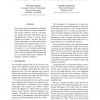Free Online Productivity Tools
i2Speak
i2Symbol
i2OCR
iTex2Img
iWeb2Print
iWeb2Shot
i2Type
iPdf2Split
iPdf2Merge
i2Bopomofo
i2Arabic
i2Style
i2Image
i2PDF
iLatex2Rtf
Sci2ools
ACL
2007
2007
A Discriminative Syntactic Word Order Model for Machine Translation
We present a global discriminative statistical word order model for machine translation. Our model combines syntactic movement and surface movement information, and is discriminatively trained to choose among possible word orders. We show that combining discriminative training with features to detect these two different kinds of movement phenomena leads to substantial improvements in word ordering performance over strong baselines. Integrating this word order model in a baseline MT system results in a 2.4 points improvement in BLEU for English to Japanese translation.
ACL 2007 | Combines Syntactic Movement | Computational Linguistics | Discriminative Statistical Word | Word Order Model |
| Added | 29 Oct 2010 |
| Updated | 29 Oct 2010 |
| Type | Conference |
| Year | 2007 |
| Where | ACL |
| Authors | Pi-Chuan Chang, Kristina Toutanova |
Comments (0)

